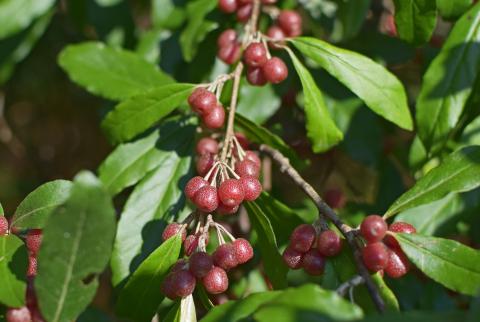Invasive in the Spotlight: Autumn Olive

Autumn olive (Elaeagnus umbellata) is an invasive woody plant native to eastern Asia. It was introduced to the United States as an ornamental plant in the 1800s. In more recent decades, autumn olive was planted to provide food and shelter for wildlife. Autumn olive is a fast growing shrub that can often reach up to 20 feet tall. The upper leaf surfaces are dark green while the undersides are covered with grayish or silver scales which give the leaves a silvery cast. Small, light yellow flowers occur in clusters of 5 to 10 and bloom in mid to late spring. Small fleshy fruits range in color from pink to red and are produced in abundance each year. An individual plant can produce up to eight pounds of fruit each season, which is readily consumed and dispersed by birds. Autumn olive is easily seen in the spring since it leafs out when most native vegetation is still dormant.
Control
In New Hampshire, autumn olive has escaped from cultivation and is progressively invading natural areas. Over time, colonies of these shrubs can grow thick enough to crowd out native plants. The best method of controlling this species is to prevent it from becoming established. Cutting autumn olive stimulates resprouting and leads to thicker growth. Young plants may be hand-pulled, especially when the soil is moist. Herbicide treatment is probably the best method for eradicating larger, well-established plants. A cut-stump treatment is done by cutting the trunk of the shrub near the base and applying an herbicide to the cut area of the stump. The herbicide is drawn into the roots and eventually kills the plant. A foliar herbicide application should eliminate smaller patches. Herbicides are most effective against autumn olive when they are used in the early summer through the fall. Before using any herbicide product always read the label and follow the manufacturer’s instructions.
Always use an Integrated Pest Management Approach.
Native Alternatives
Although the birds may love autumn olive, there are a number of better, native plant choices for providing wildlife habitat. Winterberry (Ilex verticillata), highbush blueberry (Vaccinium corymbosum), Inkberry (Ilex glabra), northern spicebush (Lindera benzoin), eastern shadbush (Amelanchier canadensis), bayberry (Myrica pensylvanica), and many other attractive native shrubs can offer both food and cover for songbirds.
UNH Cooperative Extension Master Gardener volunteers share information about home, yard, and garden topics with the people of New Hampshire. Got questions? Master Gardeners provide practical help finding answers to your questions through the Ask UNH Extension Infoline. Call toll free at 1-877-398-4769, Monday to Friday, 9 a.m. to 2 p.m., or e-mail us at answers@unh.edu.
Related Resource(s)

